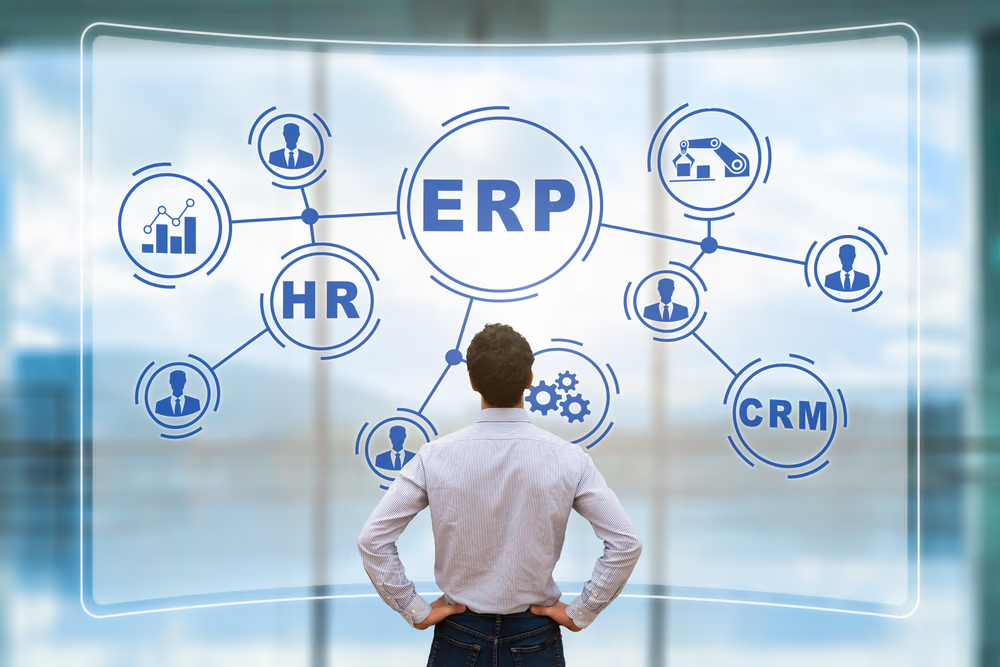Learn how EDI-ERP integration automates purchase orders, invoices, and shipment updates to streamline workflows, cut costs, and improve supply chain visibility.
Electronic data interchange (EDI) and enterprise resource planning (ERP) already play a central role in supply chain management for many organizations. However, the two systems often operate in isolation. Siloed environments typically double the workload, requiring manual data entry, which increases errors and causes delays.
EDI ERP integration closes several gaps by automating the flow of purchase orders, invoices, shipment updates, and other business documents directly into ERP software. Connecting EDI to their ERP system enables companies to streamline operations, reduce costly errors, and speed up business cycles.
This guide explains EDI-ERP integration, available approaches, and the best ways to get the most out of both systems through integration.
What Is EDI-ERP Integration?
The integration of EDI to ERP refers to the connection of EDI processes directly with ERP software. This setup allows business documents, such as purchase orders and remittances, to move automatically between trading partners and the ERP.
For example, a purchase order sent by a retailer to the supplier can flow straight into an ERP platform like NetSuite or Microsoft Dynamics without retyping the information into the enterprise system. The partner system then pushes invoices and shipping updates back out to the purchaser.
Common document types include:
Payment remittances (EDI 820)
Inventory updates (various transaction sets)
Popular ERP systems that support EDI and ERP integration include SAP, NetSuite, Microsoft Dynamics, Sage, and Acumatica. Modern API-first EDI systems like Orderful can also integrate with other similar business software, such as QuickBooks and open-source systems like Odoo, with some extra setup by an IT team.
Take a look at our Top ERP Systems for deeper insights into popular ERP platforms.
How EDI Integrates with ERP Systems
There are many ways to bring both EDI and ERP systems together, each with its own advantages and trade-offs. The right approach depends on your existing ERP platform, IT resources, and the needs of your trading partners.
Point-to-Point
Also called direct integration, this setup connects the EDI system straight into the ERP software. It can be fast and efficient if you only use a single connection, but maintaining multiple point-to-point links quickly becomes complex and costly.
Middleware, VANs, or Brokers
Many companies use a third-party provider to act as the middle layer between their ERP and trading partners. While this reduces the internal IT burden, it often adds recurring costs and can slow down onboarding.
Cloud and API-First Integrations
API-based EDI systems integrate directly with ERP solutions, while web EDI uses a cloud host to act as a go-between. These platforms are simpler in the long term. However, the upfront configuration may require some IT involvement to line everything up between the systems.
If you're considering changing your enterprise resource platform, read about How to Select an ERP System for insights that can help you select the right one for your organization's needs.
Benefits of Integrating EDI with ERP
When ERP and EDI software run separately, internal business processes often slow down under the weight of manual data entry and disconnected workflows. Integrating a modern EDI solution with ERP software creates a more connected supply chain with numerous advantages for suppliers and trading partners alike, including:
Real-time data sync: Orders, invoices, and shipping updates flow into the ERP automatically, reducing delays and helping teams and business partners stay aligned.
Reduced manual data entry: Automating document processing improves data accuracy and frees employees to focus on higher-value tasks.
Faster order processing: By cutting down on back-and-forth rekeying, EDI transactions move through business cycles more quickly, leading to faster cash flow.
Improved supply chain visibility: With electronic documents updating the ERP in real time, managers get a full view of inventory management, shipment status, and overall supply chain performance.
For example, when a large retailer sends a purchase order, the electronic document can flow straight into an ERP system like SAP or Oracle. That same integration pushes back an invoice or an advance ship notice, keeping both sides of the transaction synchronized without human input.
Together, these benefits improve operational efficiency, cut costs associated with errors, and strengthen customer satisfaction.
Common Challenges in ERP-EDI Integration
While EDI ERP integration delivers clear advantages, the process isn’t always straightforward. Many organizations encounter roadblocks that slow down implementation or add unexpected costs. Common challenges include:
Complex mapping and translation: Every trading partner may use different data formats or standards. Converting those documents into a format the ERP system understands often requires detailed data mapping and ongoing adjustments.
High costs with legacy providers: Older EDI services, such as traditional VANs, can be expensive to maintain and charge fees for each transaction, putting up obstacles to business growth.
Long partner onboarding timelines: Setting up connections with new trading partners can take weeks or months if the ERP integration process relies on manual configuration.
Limited IT resources: Teams may lack the in-house expertise to manage integrations or troubleshoot more complex issues.
These challenges highlight why more companies are moving toward modern EDI platforms that test and validate in real time, simplify onboarding, reduce costs, and keep integrations running smoothly as ERP systems evolve.
Best Practices for Integrating ERP and EDI
A successful integration requires a clear strategy and repeatable processes that keep both systems working together as business needs shift. These best practices will help you get consistent results with your EDI-ERP integration:
Start with High-Volume Transactions
Begin with the documents you exchange most often, such as purchase orders (EDI 850), invoices (EDI 810), and advance ship notices (EDI 856). These documents are relatively simple to map and ensure the biggest impact early on.
Standardize Workflows Across Trading Partners
Consistent processes reduce complexity and speed up new partner connections. Develop consistent practices for onboarding new trading partners, testing and validating transactions, and documenting exchanges across all business partners.
Automate Validation and Testing
Testing and validation before going live are essential to ensure that trading partners won't reject documents before they can be processed. Modern EDI platforms can verify transactions in real time, helping teams catch errors before they disrupt your supply chain.
Select Scalable Platforms
Modern cloud-native and API-first platforms adapt easily to ERP upgrades and integrate quickly with new trading partners. Choose an EDI solution that offers these advantages and that can support a growing business without major rework.
Following this set of best practices gives you a smoother integration process, fewer disruptions, and the flexibility to grow. With the right EDI provider, you can build a reliable integration framework that supports operational efficiency and long-term cost savings.
Modern Approaches: Cloud and API-First EDI Integration
Traditional EDI systems often depend on third-party solutions or heavy middleware to connect with ERP platforms. Legacy systems such as these are functional, but they can be costly to maintain and often make it difficult to scale. Cloud-native and API-based integrations take a different approach, connecting directly with your ERP software to provide instant communication between the two systems.
API-First EDI
API-first platforms connect directly to ERP systems through lightweight integrations. This enables seamless integration with internal and external data sources, ensuring accurate, real-time updates across the supply chain. For example, when a customer submits an order, it can move through the ERP system instantly, triggering inventory management updates and shipping workflows without manual steps.
Cloud EDI
Cloud-based EDI solutions rely on a hosted platform that sits between the ERP system and trading partners. Instead of managing on-premise software or multiple point-to-point connections, companies use a centralized hub in the cloud to handle data exchange. This setup routes business documents through secure connections, automatically translating them into the formats the ERP system can process.
API-first and cloud EDI solutions future-proof your company by providing the tools you need to adapt to changing trading partner requirements and customer demands. They also improve data integrity by automating document processing and validation. Instead of waiting days to test and approve trading partner connections, you can onboard new partners in a matter of hours. This accelerated business cycle speed is one of the main reasons companies are shifting away from legacy software toward modern EDI platforms.
Smarter ERP and EDI Integration for the Future
Bringing ERP and EDI systems together is vital for companies that want to stay competitive. Integrated platforms give teams the agility they need to keep supply chains moving at full speed. As more businesses move away from legacy software, cloud and API-first solutions are setting the standard for seamless integration.
The right EDI solution can make the difference between stalled projects and long-term success. Modern platforms simplify the integration process and can expand as your business grows. If you’re ready to build a solution that’s both efficient and future-ready, speak with an EDI expert today.
FAQs About EDI ERP Integration
What is EDI ERP integration?
EDI ERP integration is the process of connecting electronic data interchange (EDI) with enterprise resource planning (ERP) software. It enables business documents like purchase orders, invoices, and shipping notices to move automatically between trading partners and the ERP system, reducing manual data entry and errors.
How does EDI integrate with ERP systems?
EDI integrates with ERP systems through point-to-point connections, middleware or value-added networks (VANs), and modern API-first or cloud EDI platforms. API-first platforms connect directly to ERP systems for real-time updates, while cloud-based solutions act as hubs that translate and route EDI documents between trading partners and ERP software.
What are the benefits of ERP and EDI integration?
The main benefits include faster order processing, fewer manual errors, real-time visibility into transactions, and improved partner collaboration. Integrating ERP and EDI also reduces IT workload, accelerates cash flow cycles, and ensures compliance with partner requirements.
What challenges do companies face with EDI ERP integration?
Common challenges include complex data mapping, partner-specific formatting requirements, high costs with legacy EDI providers, and long onboarding timelines. Limited IT resources can also make integration harder without modern platforms that simplify and automate the process.
Which ERP systems support EDI integration?
Popular ERP systems that support EDI integration include SAP, Oracle NetSuite, Microsoft Dynamics, Sage, Acumatica, and Odoo. Many can connect to API-first EDI platforms like Orderful for faster, more scalable integrations with trading partners.
How does cloud EDI simplify ERP integration?
Cloud EDI simplifies ERP integration by hosting EDI operations in a centralized platform. It removes the need for on-premises hardware, accelerates trading partner onboarding, and supports real-time data exchange. With cloud EDI, businesses gain scalability, predictable costs, and improved visibility into supply chain activities.
- 01What Is EDI-ERP Integration?
- 02How EDI Integrates with ERP Systems
- 03Benefits of Integrating EDI with ERP
- 04Common Challenges in ERP-EDI Integration
- 05Best Practices for Integrating ERP and EDI
- 06Modern Approaches: Cloud and API-First EDI Integration
- 07Smarter ERP and EDI Integration for the Future
- 08FAQs About EDI ERP Integration
- 09(Placeholder)

